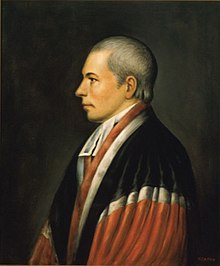Our website is made possible by displaying online advertisements to our visitors.
Please consider supporting us by disabling your ad blocker.
William Paterson (judge)
William Paterson | |
|---|---|
 | |
| Associate Justice of the Supreme Court of the United States | |
| In office March 11, 1793 – September 9, 1806[1] | |
| Nominated by | George Washington |
| Preceded by | Thomas Johnson |
| Succeeded by | Henry Livingston |
| 2nd Governor of New Jersey | |
| In office October 29, 1790 – March 30, 1793 | |
| Preceded by | Elisha Lawrence (acting) |
| Succeeded by | Thomas Henderson (acting) |
| United States Senator from New Jersey | |
| In office March 4, 1789 – November 13, 1790 | |
| Preceded by | Seat established |
| Succeeded by | Philemon Dickinson |
| Attorney General of New Jersey | |
| In office 1776–1783 | |
| Governor | William Livingston |
| Preceded by | Position established |
| Succeeded by | Joseph Bloomfield |
| Personal details | |
| Born | December 24, 1745 County Antrim, Ireland |
| Died | September 9, 1806 (aged 60) Albany, New York, U.S. |
| Political party | Federalist |
| Spouses | Cornelia Bell
(m. 1779; died 1783)Euphemia White (m. 1785) |
| Children | 3 |
| Education | Princeton University (BA, MA) |
| Signature | |
| Military service | |
| Allegiance | |
| Branch/service | |
| Rank | Commissioned Officer |
| Unit | |
| Battles/wars | American Revolutionary War |
William Paterson (December 24, 1745 – September 9, 1806) was an American statesman, lawyer, jurist, and signer of the United States Constitution. He was an Associate Justice of the United States Supreme Court, the second governor of New Jersey, and a Founding Father of the United States.
Born in County Antrim, Ireland, Paterson moved to the North American British colonies at a young age. After graduating from the College of New Jersey (now Princeton University) and studying law under Richard Stockton, he was admitted to the bar in 1768. He helped write the 1776 Constitution of New Jersey and served as the New Jersey Attorney General from 1776 to 1783. He represented New Jersey at the 1787 Philadelphia Convention, where he proposed the New Jersey Plan, which would have provided for equal representation among the states in Congress.
After the ratification of the Constitution, Paterson served in the United States Senate from 1789 to 1790, helping to draft the Judiciary Act of 1789. He resigned from the Senate to take office as governor of New Jersey. In 1793, he accepted appointment by President George Washington to serve as an associate justice of the Supreme Court. He served on the court until his death in 1806.
- ^ "Justices 1789 to Present". Washington, D.C.: Supreme Court of the United States. Retrieved February 15, 2022.
Previous Page Next Page


